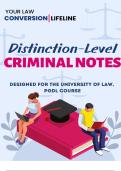Summary
Summary Criminal Law Notes (DISTINCTION) for University of Law Post Graduate Diploma in Law (PGdL) course
- Course
- Institution
Distinction level Criminal Law notes (average of 82 in this module) Crafted by a recent graduate who received a distinction in the very same course, these notes are tailored to your PGDL program, ensuring they cover the crucial Criminal Law concepts you need to master. Aligned with the PGDL ...
[Show more]



